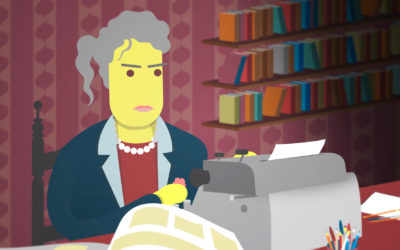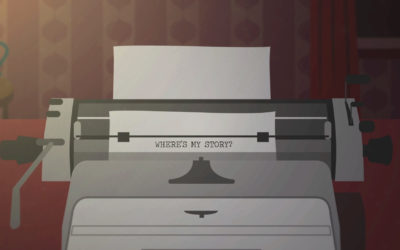19. THE FATEFUL EIGHT SECONDS
As Watson enters the room we see Sherlock reading a newspaper. On one page, the headline reads: ‘Eight Seconds of Sporting Genius!’ The choice of headline was intentional. It refers to a copyright case involving the use of eight-second clips of a sports broadcast.
In this Case File #19 we consider how the concept of substantial copying applies to broadcasts and films, and why the exception to copyright for reporting current events is important for both media organisations and ‘citizen journalists’.
SUBSTANTIAL COPYING
Copyright protection is not confined to preventing the copying or use of works in their entirety. Simply copying part of the work can also infringe. On the other hand, copying an insubstantial part of a copyright work without permission is allowed. This is because the law recognises that no real injury is done to the copyright owner if only an insignificant part of the work is copied.
In earlier Case Files we consider the concept of substantial copying in relation to artistic works (see Case File #7 The Matching Wallpaper) and literary works (see Case File #9 The Improbable Threat). In this Case File #19 we consider what substantial copying means in relation to broadcasts, films, and other types of audiovisual work.
Whatever type of work you are dealing with, substantial copying is considered by the courts to be a matter of quality, not quantity. So, it is not just about how much you copy from someone else’s work, it is about the importance or value of the copied parts in relation to that work. This is because a small part of the original work may be highly significant to the piece as a whole. This focus on the quality rather than the quantity of what has been copied can make it difficult to define precisely what amounts to a substantial copying.
This distinction between quantitative copying (that is: how much have you copied?) and qualitative copying (that is: how important or significant is the part that you have copied?) is well illustrated by the decision of England and Wales Cricket Board v. Tixdaq (2016).
THE CASE: England and Wales Cricket Board v. Tixdaq (2016)
The England and Wales Cricket Board (the ECB) own copyright in the television broadcasts and films of most cricket matches played by the England men’s and women’s cricket teams. The defendants, Tixdaq, operate a website (www.fanatix.com) and an App that provides users with eight-second clips of broadcasts of cricket matches. Many of these clips were uploaded by the defendants themselves, but users also uploaded clips to the App service. These clips could also be seen on the defendants’ Facebook page and Twitter feed.
The ECB sued for copyright infringement. They argued that the use of an eight-second clip from over two hours of footage amounted to substantial copying. The defendants disagreed, arguing that a single eight-second clip could not be considered to be substantial. Mr Justice Arnold, the presiding judge, held for the ECB on this point. He commented as follows:
Quantitatively, 8 seconds is not a large proportion of a broadcast or film lasting two hours or more. Qualitatively, however, it is clear that most of the clips uploaded constituted highlights of the matches: wickets taken, appeals refused, centuries scored and the like. Thus most of clips showed something of interest, and hence value … Accordingly, in my judgment, each such clip constituted a substantial part of the relevant copyright work(s).
The fact that the clips were very short did not matter. What mattered was that they showed something of interest; they were qualitatively significant.
REPORTING CURRENT EVENTS
UK copyright law provides a number of exceptions to copyright for specific circumstances when work can be used without needing permission from the copyright owner. There are various exceptions set out in the Copyright, Designs and Patents Act 1988 concerning non-commercial research and private study, quotation, news reporting, education, and other uses.
In the Tixdaq case, the defendants argued that, even if the clips used amounted to a substantial part of the ECB’s work, they still had a defence in the guise of the exception for reporting current events. But, were the clips posted by the defendants and by users of fanatix.com really uploaded for the purpose of reporting the news? Traditionally, this exception has been relied upon by professional journalists and the newspapers, broadcasters and media organisations for which they work. The question for the court was whether the exception also extended to use on social media by fans creating and sharing their own reports; that is: ‘citizen journalists’.
In considering this question Mr Justice Arnold observed that the purpose of the exception for reporting current events was ‘to provide an exception to copyright in the public interest, namely freedom of expression’. It is an exception, he continued, that must take into account ‘recent developments in technology and the media’. With that in mind, the judge commented that ‘[i]f a member of the public captures images and/or sound of a newsworthy event using their mobile phone and uploads it to a social media site like Twitter, then that may well qualify as reporting current events even if it is accompanied by relatively little in the way of commentary’.
In this particular case, however, Mr Justice Arnold decided the exception did not apply. The main purpose of fanatix.com, he concluded, was simply to share clips of footage of sporting events, rather than to provide information or commentary about those events. Ultimately, the judge decided, the purpose of fanatix.com was purely commercial and not informatory.
FOR DISCUSSION: NO PHOTOGRAPHY PLEASE
Newspapers often use photographs to accompany and illustrate their reports and stories. Indeed, in our film, the article in the newspaper that Sherlock is reading is accompanied by a photograph of a cricketer. However, the exception for reporting current events applies to all types of copyright work except photographs. That is, you cannot use photographs protected under copyright for reporting current events without obtaining the permission of the respective copyright owner.
So, if you were a ‘citizen journalist’ with your own blog on newsworthy events the exception for reporting the news allows you to upload short clips of other people’s broadcasts or films to your blog (so long as your use is considered fair) but not to make use of other people’s photographs. Why do you think photographs are treated differently under this exception from every other type of protected work?
USEFUL REFERENCES
Copyright Designs and Patents Act 1988: http://www.legislation.gov.uk/ukpga/1988/48/contents
England and Wales Cricket Board Ltd [the ECB] & Anor v. Tixdaq Ltd & Anor [2016] EWHC 575 (Ch), available here: www.bailii.org/ew/cases/EWHC/Ch/2016/575.html
For further commentary on the exception for reporting current events, see here: https://www.copyrightuser.org/understand/exceptions/news-reporting/
Download the PDF version of Case File #19 – The Fateful Eight Seconds.
More Case Files
13. The Multiple Rights
Mary Westmacott is a freelance screenwriter; she writes scripts for films. Scripts are written works that contain the words of a film (or a play, television programme, video game, and so on)…
14. The Missing Manuscript
The missing manuscript is the original script written by Mary and commissioned by Money Tree Productions. The term ‘original’ has different meanings depending on the context.
15. The Dream Job
Mary accepts a commission to write ‘an original script’ for ‘a film about a missing boy,’ not just for the ‘intriguing premise’ but also because ‘for once the contract terms were great; a dream job that would pay the bills for many years’.
16. The Pantages
When Mary sees Lord Vane at the entrance of the Pantages theatre, there is a paperboy distributing copies of the Evening Paper with the headline ‘The Suicide of the sculptor Harkin and tonight’s play at the Pantages’…
17. The Typewriter
The design of the typewriter that Mary uses to write her scripts was inspired by Jack Torrance’s typewriter in Stanley Kubrick’s The Shining. Famously, Kubrick’s The Shining is a film adaptation of Stephen King’s novel with the same title.
18. The Purloined Letters
Before she was murdered, Mary Westmacott had become increasingly concerned for her safety and state of mind. In her letter to Holmes she describes how, one night…
20. The Lawful Reader
The headline ‘News Just In! Reading the internet is the same as reading a book’ refers to a copyright case in which the courts were asked to consider whether simply reading material online might infringe copyright.
21. The Six Detectives
Mary’s problems began when she ‘started fleshing out the main character: the hero-detective’. Before settling on one and starting seeing the others everywhere, she considered six potential protagonists for her story.
















